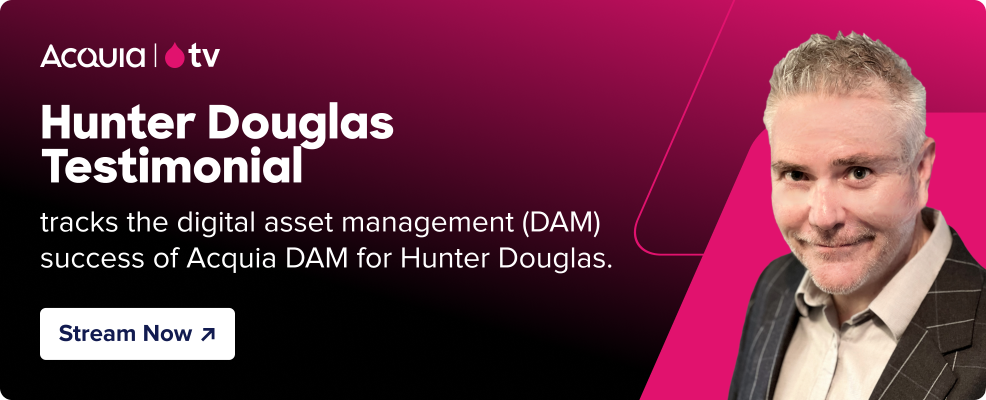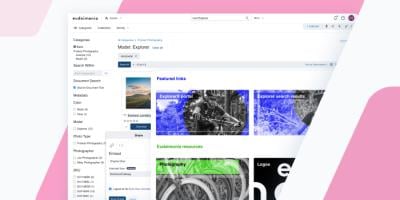Understanding Types of Marketing Collateral

Nate Holmes
Sr. Manager, Product Marketing
The use of marketing collateral is not a new strategy. Yet, the concept and execution itself is worth revisiting every now and again. Like most things, it’s not static. Business environments, new technologies, and consumer trends all play a role in how customers respond to marketing collateral and how businesses use it. So what better time than the present to rewrite definitions, reassess best practices, and re-evaluate if you’re really getting the most out of your efforts?
What is marketing collateral?
Marketing collateral is any digital or printed material used to communicate or promote a company’s brand message, products, or services. Marketing collateral includes a variety of formats ranging from printed brochures to point-of-sale posters, videos, e-books, newsletters, graphics, and more. When determining which type of marketing collateral is right for your organization, it’s important to think about what you need it to achieve. |
While every organization has different goals and budgets, businesses that create marketing collateral typically use it as a sales support tool. They leverage it to spread awareness and drive adoption for an offering. They rely on it to attract and gain new, qualified leads. And they use it to support existing customers, drive brand loyalty, and ultimately win repeat business.
With that said, marketing collateral isn’t only an asset to sales teams. Many organizations also use it to achieve goals unrelated to revenue. Think about a company that’s dealing with low employee morale, for example. They could use marketing collateral to promote new initiatives aimed at improving workplace culture. Or an organization undergoing a corporate rebrand could use marketing collateral to drive adoption of their new brand identity and guidelines. Whatever the case, marketing collateral has applications for any audience and any goal — you just need to determine what type of marketing collateral to create.
Types of marketing collateral
Marketing collateral can be utilized in both traditional and digital marketing channels — and you’re likely to use a healthy mix of collateral types as part of your approach. Depending on your audience, budget, and goals, you can determine which types of marketing collateral deserve a place in your content arsenal. While new types pop up regularly, there are a bevy of options that marketers consistently rely on.
1. Banner ads
Also referred to as a display ad, a banner ad is essentially the online equivalent of a roadside billboard. Placed in prominent spaces on publisher websites, banner ads are used to catch an audience’s attention and drive them to your website or offering. The best banner ads are visual in nature, include simple and direct messaging, have a call to action (CTA), and feature clear branding.
2. Blog posts
Perhaps the most popular form of marketing collateral, blog articles are an excellent way to attract new prospects and support your existing clients. You can create blog posts for your website or show off your expertise as a guest contributor on partner sites. Just make sure the content you’re producing is helpful to your audience and not just an excuse to promote your products and services.
3. Brand magazines
Organizations typically use brand magazines in two different ways: to share information about their products and services, or to support their audience through content marketing. The first use case is more promotional in nature and includes collateral like product catalogs. The second strategy is less explicit, relying on articles and information that appeal to a specific audience.
4. Brochures
Brochures are pamphlets that typically contain information about a company and its products or services. They range from simple and inexpensive booklets to high-gloss, high-design materials. Brochures should be scannable, so leverage visuals and short, catchy copy or bullet points to tell your story. The crowded, long-form stuff has no place in brochures.
5. Direct mail
The use of direct mail, or communications sent via postal mail, has been around since ancient Egyptian times. Yet, it still has a place today. Don’t get us wrong; there’s a lot of junk mail that shows up in everyone’s mailbox. However, with the right audience targeting, you can reach people with mail they actually want. For example, if you know someone attended one of your conferences in the past, a coupon for a free gift at this year’s events seems appropriate.
6. Displays
Eye-catching displays — or exhibits placed in prominent locations — come in many shapes, sizes, and formats. Roadside billboards, shelf signage, point-of-sale (POS) stands, and even interactive product kiosks are a few examples. To determine the display that’s right for you, start with your goals and consider your budget. Do you need a display that will grab customers’ attention? Or, are you looking to engage, entertain, or educate? How much do you have budgeted to spend on this new piece? Asking yourself questions like these will help inform your strategy.
7. E-books
E-books are long-form content that individuals or businesses create to educate readers and demonstrate their expertise on a specific topic. While also educational, e-books tend to be more entertaining and less technical or in-depth than white papers. They are considered premium content, so depending on your strategy, you could ask people for an email address or even a fee in return for access.
8. Infographics
Looking to present information in an easy-to-digest format? Infographics might be just the ticket. Giving readers a much-needed break from dense text, infographics are visual representations of information or data. They are great for storytelling, simplifying complex subjects, and winning audience attention. Just remember that no matter how creative you get, your brand should still be recognizable.
9. Logos
Logos are an important piece of marketing collateral that have the ability to make your brand recognizable in a single glance. Your logo evokes your brand’s purpose and personality, and lets the world know who you are. It’s a foundational element of your marketing and should be given a fair bit of attention in order to get it right. That’s not to say your logo won’t evolve over time, but any changes you make should be deliberate and meaningful.
10. Newsletters
A popular email marketing strategy, newsletters are a valuable tool to get your brand content directly and regularly into your prospects’ and customers’ inboxes. Newsletters take on many forms and frequencies. It can be a daily round-up of the top industry news, or it can be a quarterly missive featuring customer success stories. No matter which route you choose in launching a newsletter, keep in mind that a newsletter should be more informational than promotional, otherwise you run the risk of turning off your readers and having them unsubscribe.
11. Podcasts
Podcasts are incredibly popular – it seems like just about everyone has one these days. But just having a podcast doesn’t equal marketing success. While they can pay off big time when done well, you have to really understand your audience and deliver stellar content to stand out in the crowd. Podcasts aren’t just a side project for a marketing team; they take dedicated resources to be successful.
12. Reports
If you have proprietary research, data, or findings, reports are an excellent way to share your learnings and prove your subject matter authority and dedication. Plus, people appreciate legit intel that’s backed by research and they may even quote you! Need an example of a report? Check out Acquia’s annual Customer Experience Trend Report.
13. Reviews
Reviews are a powerful form of marketing collateral, yet they’re really not up to your marketing team to create. They’re truly a culmination of your branding and customer service efforts. From B2B review sites like G2 and Capterra to star ratings on individual products, reviews can make or break a product – or even a company – and deserve attention as part of your marketing efforts.
14. Sell sheets
A sell sheet, also called a one-pager, is a downloadable document or webpage that summarizes the most compelling benefits, features, and aspects of a product or service. The most effective sell sheets don’t overwhelm readers. They are comprehensive but use imagery to help communicate important information, such as what a product looks like.
15. Social media
In today’s marketing world, having a social presence is basically required for any business, but that doesn’t mean you need to be on every available platform. With so many channels available, teams need to be strategic about where they spend social media marketing time and effort. Identifying your target audience will help narrow down the platforms to focus on so you can create a great experience on those channels instead of a lackluster one across multiple platforms.
16. Specialty items
Swag (stuff we all get) is still a widely popular form of marketing collateral that businesses use to establish rapport and brand awareness. Blankets, bags, pens, phone chargers, stickers, water bottles, and more — there’s nothing organizations aren’t branding and doling out. Be creative but deliberate. Think about what your audience will actually use and ensure it aligns with your organization’s beliefs. In other words, if you’re an environmental brand, don’t hand out a bunch of swag that’s bad for the earth.
17. Testimonials and case studies
A great way to highlight customer success is with testimonials and case studies. Putting the spotlight on your customers can show the value of your company and products without feeling like a sales pitch. These are often used as part of the buying process or as a way to inspire other customers to use your products in a new or different way.
18. Videos
Video is a popular format businesses use to reach audiences and inspire action. And it’s easy to see why. With 90% of marketers saying video marketing has given them a good return on investment (ROI), it’s worth your consideration. Test the waters and find formats that will help you achieve your goals. From how-to explainers and demos to interviews, product overviews, testimonials, and more, there’s a lot you can do with video – just check out what we’ve been up to with video at Acquia TV.
19. Visual content
Okay, a lot of the examples above, such as infographics and videos, are considered visual content. Even text-based marketing collateral like a blog can be considered visual content if it incorporates images, charts, videos, or other visuals throughout. The term is somewhat of a gray area, but worth circling back on. Visual content — no matter what you call it — is marketing collateral. A white paper or report with visual elements? Visual content. Standalone brand assets like GIFs, memes, diagrams, screenshots, or product images? Also visual content. So, it turns out most marketing collateral is (drumroll, please) … visual content.
20. Webinars
A webinar is a seminar or presentation hosted online. Many organizations host live webinars, complete with audience participation. However, that’s not the only option. Pre-recorded webinars are also a popular choice. Whatever the case, squeeze as much value out of your webinar as possible by repurposing its information into other marketing collateral, such as blog posts.
21. Websites
While most people don’t think of their company website as marketing collateral, it sure is. In fact, it’s a curated collection of some of your most powerful collateral. After all, don’t most examples on this list live on your website? Additionally, every standalone landing page you create or deep-dive pillar page you build is even more marketing collateral. Moral of the story? Treat your website with care and ensure it’s a strong marketing asset.
22. White papers
Originally, white papers were a tool for legislators to explain or make a case for a particular political solution. Today, white papers have broader industry applications but are still very much problem-solving guides. If you have a point of view (and the expertise to back it), white papers are an excellent way to present in-depth, authoritative, and persuasive information and solutions. Don’t be afraid to break up the text with some visuals — your audience will thank you.
How to create great marketing collateral
Now that you’ve got a list of marketing collateral examples to explore, it’s time to get creative. Creating marketing collateral for the sake of “having something” is not worth the time, money, and energy it takes to produce and distribute it. To create great marketing collateral, you need a plan, goals, and skilled people to craft effective and professional-looking materials. But that’s easier said than done, right? Well, not necessarily. You just need to know where to start.
1. Put your audience first
While it may sound obvious, you absolutely must keep your audience in mind when creating marketing collateral. Who are you talking to? What are their pain points, concerns, motivators, likes, and dislikes? Using a customer data platform (CDP) can help you understand who you’re talking to so you can create content that helps them make a decision, solve a problem, or achieve whatever goal they’re after.
2. Stay true to your brand
Regardless of how different each piece of marketing collateral is, your brand should be a constant. Whether you need to ensure designers are using the same shade of red across logos or your marketing team only uses stock photos with a certain look and feel, you need brand consistency. To safeguard against misuse, it’s critical to establish brand guidelines. Technology, such as a digital asset management (DAM) platform, can also help by ensuring that people have access to marketing collateral and design files, but only those that are approved and on brand.
3. Let data inform decisions
You can create marketing collateral day in and day out, but unless you know (like, really know) it’s effective, it’s not worthwhile. Figure out what’s working and not working, so you can optimize your efforts. Talk to customers about what content they need, but also look at the numbers. Tools like Google Analytics, DAM Insights, and even analysis of unique identifiers like redemption codes are great ways to get the actionable, hard data you need.
DAM for marketing collateral
Creating your marketing collateral is only half the battle. Being able to access and use the content you create is the other half of the equation. With so much time and resources invested, you want to make sure you’re getting everything you can from your efforts.
A DAM solution gives teams secure, self-serve access to your content. With features like on-the-fly conversion formats and version control, teams can ensure they have access to what they need when they need it, all while maintaining brand consistency. And once your content is out in the world, you can keep tabs on it with DAM and digital rights management as well.
It’s not only about first-time use, either. Your marketing collateral could find new life through repurposing and reuse. Making content easily accessible opens it up to a new world of possibilities. Perhaps a web banner could be used in a presentation the sales team is putting together. Or a marketing video might be used by human resources as part of their recruiting efforts. Storing content in a DAM system allows brand managers to provide access to assets according to who is using them and how they should be used, ensuring adherence to your brand guidelines.
Bringing it all together
There’s no way around it: creating powerful marketing collateral takes time, money, and energy. But if you approach it the right way, it’s a tremendous asset to your entire organization. Digital asset management, or DAM, is one way to ensure you get the most out of your marketing collateral and all of the visual assets you need to create it.
To learn more about Acquia DAM (Widen) and how we can help you manage your most powerful marketing assets, request, watch, or click through a demo today.

This blog was originally published in 2022 and has been updated to remain current.


